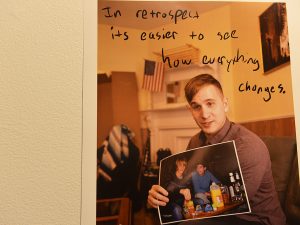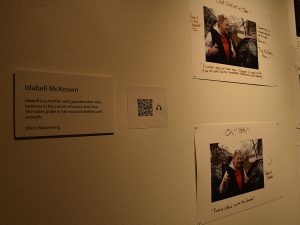Journalism Students’ Multimedia Project Changes Narrative of Opioid Epidemic
Emerson Journalism students created a multimedia exhibit that tells human-centered stories about people recovering from opioid addiction. Photo/Molly Loughman
By Molly Loughman
Not so long ago, Jillian Concannon could be found passed out on streets of Boston — overdosing, getting robbed, and racking up possession charges. Now, she’s one year sober and on her way to working with Quincy Drug Court, an inspiring recovery story not often seen in the media.
This spring, Emerson Journalism students in Assistant Professor Aaron Goodman’s Humanizing Multimedia Stories class are helping to change the narrative around America’s deadliest drug crisis, the opioid epidemic, through an innovative multimedia exhibition, RECOVERING, which can be explored online.
To personalize Concannon’s and other people’s roads to recovery from physical and psychological addiction, the class partnered with individuals in South Boston’s Devine Recovery Center, a peer-to-peer community center giving support for people in recovery from various types of addictions.
“I buried both my brothers to this, so I’m the only one left of the siblings,” said Concannon. “I never thought three years ago when I was watching people go to work every day while I was sitting/sleeping on stairs, that I’d be that person going to work every day and being a member of society. There are a lot of areas of my life I have to look at and fix and it’s going to take a while, but I hold onto hope. I’m just starting to live my life and it’s such a beautiful thing. Recovery is possible.”

None of the multimedia in the RECOVERING exhibition depict slumped-over bodies or people using drugs. Rather, the mix of images and handwritten personal messages inside the Huret & Spector Gallery amplifies the voices and experiences of various individuals’ recovery from substance use disorder in the Boston area.
“[In media depictions, we observed] a lot of passed out people, a lot of needles in arms, a lot of people sleeping on the streets, a lot of people whose faces weren’t even shown — It was very dehumanizing. It just made the opioid crisis seem detached and is something that is the fault of the person it’s happening to,” said Journalism sophomore Albany Alexander, one of the Emerson students who uncovered layers of Concannon’s story via multimedia seen in the gallery.
“We saw some journalists fall short in choosing not to invest the time in telling the full story. And so, this gallery, we hope, represents people as a whole of their journey, and not just one second of their worst moment in order to be dramatic and just get the story out.”
Throughout the semester, students in Goodman’s class spent time with 12 individuals in recovery, taking photos of them the way their subjects wanted to be depicted. The students then took the rare steps of showing the images to their participants and inviting them to write their thoughts and feelings on the photographs. In the classroom, students examined the history of the opioid crisis, which claimed more than 70,000 lives in 2017 alone, and its portrayal in media.

“I think [this project] really goes to the heart of the mission of Emerson College and the School of Communication. We talk about empathy all the time, we talk about listening, connecting with people through conversation, expression,” said Dean of the School of Communication, Raul Reis during the exhibition’s opening reception earlier this month. “It also represents the cutting-edge, innovative work we’re doing,”
“We know the opioid crisis is beyond just that term. It is about people, it is about human beings – hence the name of this class – and hence the idea of why this approach is so necessary,” said Journalism Department Chair Janet Kolodzy.
A multimedia producer and journalist with a focus on documentary filmmaking, Goodman spent a year documenting the lives of three heroin users in Vancouver who took part in a prescription heroin treatment program. Despite its scientific proven effectiveness for treatment, the program was shut down by the government, which deemed it immoral, explained Goodman, who presented the three people and their deeply personal road to recovery through multimedia work.
“Together, we are contributing to a new culture of journalism. Does this mean there will be no more pictures of passed out bodies and needles in arms? No. Are we moving in a different direction? Yes. We’re showing it’s possible to be professional journalists and to have empathy, rather than taking advantage of vulnerable people,” Goodman said.
Categories